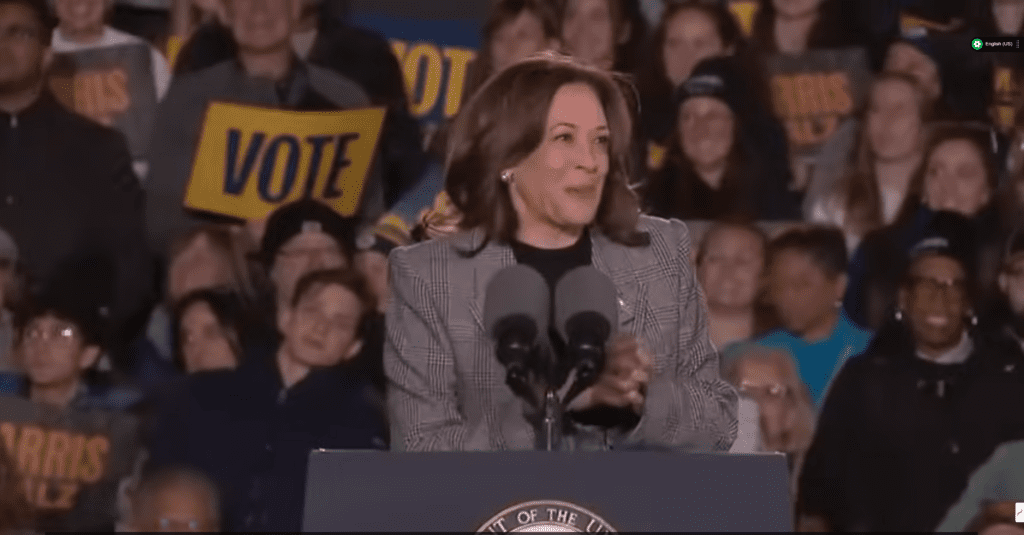
On October 28, 2024, former President Donald Trump and Vice President Kamala Harris held rallies in Atlanta, Georgia, and Ann Arbor, Michigan. These events offered a revealing look at the contrasts between the candidates’ visions, with each speech reflecting distinct approaches to America’s challenges and future. By examining their rhetoric, policy focus, and emotional appeals, we gain insight into how each candidate appeals to their base—and how they each offer a different path forward.
Economic Policies: Traditionalism vs. Working-Class Focus
With the economy a top concern for voters, Trump and Harris approached the issue from very different angles. Trump emphasized economic nationalism, pledging to “bring back” American jobs through tariffs and rollbacks of regulations, suggesting that this return to traditional economic policies would restore a “golden age” for America. His rhetoric evoked the idea of American self-sufficiency and strength, appealing to voters concerned with globalization and job security.
Harris, on the other hand, framed her economic message around working-class struggles, promising to reduce costs for essential goods like housing, healthcare, and groceries. She highlighted corporate accountability, vowing to tackle price gouging and provide middle-class tax relief. By contrasting her policies with Trump’s, which she described as favoring the wealthy, Harris positioned herself as an advocate for economic fairness and support for working families.
Reproductive Rights: Freedom and Tradition
Trump and Harris’s stances on reproductive rights also underscored their ideological differences. Trump celebrated his appointment of Supreme Court justices who overturned Roe v. Wade, framing this as a victory for conservative values. His focus on “traditional” values appeals to those who see this as a return to a more stable, structured society.
Harris presented a counter-narrative, addressing the personal impact of restrictive abortion laws and pledging to restore reproductive freedoms if elected. Her stance represents a broader movement for personal autonomy and women’s rights, aligning her with advocates of individual freedoms. The emotional weight in her approach, especially as she referenced real-life impacts on women, underscored her commitment to expanding, rather than restricting, personal freedoms.
Democracy and Governance: Nationalism vs. Collective Strength
A pivotal theme in both rallies was the future of American democracy. Trump presented his campaign as a battle to “take back” the country from “radical leftists,” positioning himself as the sole figure who could restore order and protect national security. His language suggested that he alone stood as a bulwark against those who would undermine American traditions and safety, resonating with voters who feel alienated by rapid social changes.
Harris’s approach to democracy emphasized inclusivity and collective responsibility. Urging voters to protect democratic values, she positioned her campaign as a movement for unity and empowerment. Her message framed her as the candidate of national progress, with an inclusive agenda that would uphold democratic values and restore integrity to governance.
Trump’s Combative Nationalism
Trump’s tone was aggressive and provocative, embodying elements often found in populist and nationalist rhetoric. By framing Harris and her allies as radical threats to America, he portrayed his campaign as a “battle” to defend American traditions. This appeal to an “us vs. them” mentality, combined with his language of “taking back” the country, evokes characteristics common in authoritarian movements, including those seen in 1930s Germany. Like many nationalist leaders, Trump’s rhetoric relied on invoking a sense of loss, fear, and nostalgia, promising a return to stability under his leadership.
Harris’s Inclusive Optimism
In contrast, Harris’s speech was optimistic, frequently using terms like “together,” “future,” and “freedom.” Rather than isolating enemies, her tone called for unity and progress, framing her policies as a step forward for all Americans. By avoiding personal attacks and instead focusing on her goals for the nation, Harris aimed to reassure her audience and promote hope. Her inclusive language positioned her as a leader for all, contrasting Trump’s focus on protecting “traditional” America from perceived threats.
Trump’s Fear-Based Appeals
Trump often played on fear, especially around issues like immigration, which he portrayed as an immediate threat to American communities. His emphasis on protecting “traditional values” and national security resonated with those feeling left behind or anxious about social change. This approach, tapping into the language of threats and a need for strong leadership, underscores Trump’s appeal to those seeking comfort in a return to past stability.
Harris’s Hopeful, Empathetic Appeal
Harris’s emotional appeal was rooted in empathy and optimism. Her speech frequently referenced her personal background, positioning her as a leader who understands the struggles of middle-class Americans. By emphasizing the power of unity and the potential for positive change, she appealed to voters’ desire for progress, framing her campaign as a movement toward a brighter, more inclusive future.
The rallies on October 28 underscored the candidates’ contrasting visions and values. Trump’s rhetoric leaned heavily into themes of nationalism and traditionalism, framing his leadership as essential to “saving” the country from radical threats. Harris, in contrast, offered a hopeful, inclusive vision, focusing on democratic values, economic justice, and personal freedoms.
Ultimately, these rallies highlighted the ideological battle shaping the 2024 election. Trump’s rally resonated with those who feel nostalgia for a simpler, more stable past and who are wary of rapid social change. Harris’s rally, however, struck a chord with voters who prioritize inclusivity, progress, and democratic ideals, promising a future of collective strength and shared prosperity. As the election approaches, these competing messages will shape the national dialogue, offering voters two distinctly different paths forward.